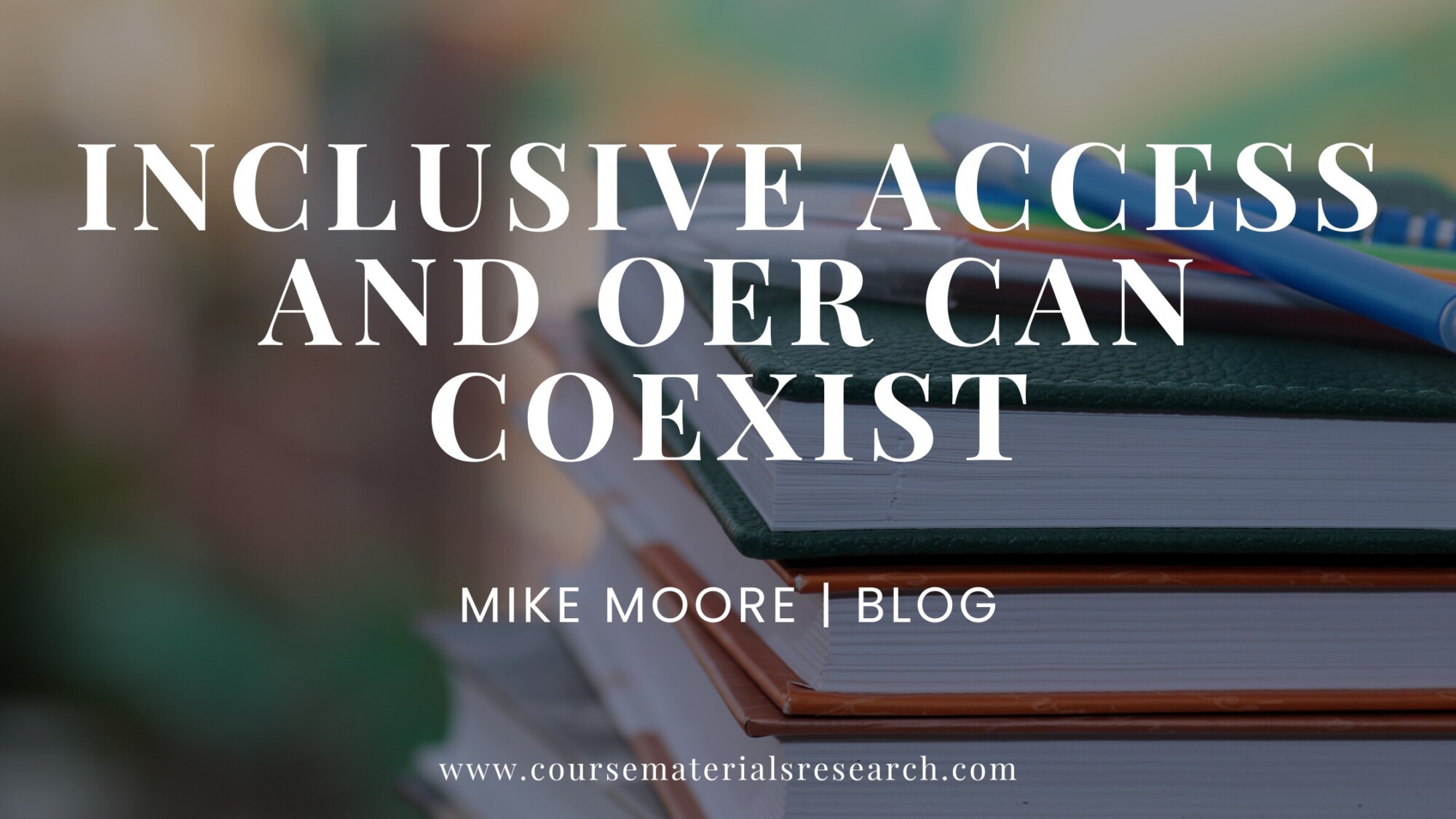Inclusive Access and OER Can Coexist

Inclusive Access and Open Educational Resources Can Coexist
Over the last five years, the growth of Inclusive Access (IA) and Open Educational Resources (OER) has sparked wild discourse within course materials and higher education. Rather than getting bogged down in the debate between the use of the Inclusive Access and OER, I want to discuss how these two course materials models can coexist and complement each other in providing students with affordable and accessible course materials. As a reminder, Inclusive Access focuses on providing, mostly digital, access to publisher driven content at reduced costs. Whereas, OER provides access to open access resources that can be used, adapted, and shared by anyone. Digital OER is generally free but print versions do cost students to obtain. So, let’s think about how IA and OER can work together to impact the most students across higher education with reduced costs and increased access to course materials.
Coexisting Course Materials
Supporters and opponents of IA and OER seem to be diametrically opposed to each other, but the reality is that both models can and need to coexist in higher education. Rather than a “one or the other” mentality, all course materials stakeholders need to embrace the other to support students on their academic journey. Here are a few ways that support the coexistence of IA and OER in higher education.
– Cost and Quality
Inclusive Access provides students with more affordable access to publisher-driven materials, while OER offers generally free resources. Having both options available on campus can strike a balance between cost and quality. This ensures students have access to a range of materials that best fit their financial and educational needs. For students from low-income backgrounds or underrepresented student groups, this can help address issues of equity and access to higher education.
– Innovation in Teaching and Learning
Having both Inclusive Access and OER available on campus can foster a culture of innovation and creativity in teaching and learning. Faculty members can experiment with different types of resources, combining the strengths of publisher-driven content in Inclusive Access with the flexibility and adaptability of OER. This combination can lead to more engaging, effective, and student-centered learning experiences.
– Diverse Course Needs
Different courses may require different types of resources. Things like subject matter, course objectives, and learning outcomes may impact course materials choices for faculty. Inclusive Access can provide students with access to high-quality publisher-driven content that may be more suited to certain disciplines or topics. Simultaneously, OER can offer customizable and adaptable resources that can be tailored to the specific needs of other courses, particularly when faculty want to create unique learning experiences or address interdisciplinary topics.
– Faculty Choice
Offering Inclusive Access and OER options, empowers faculty members to choose the resources that best align with their pedagogical needs, course objectives, and personal beliefs about course materials and education. This can promote a sense of autonomy and ownership among faculty, as they can select the materials that best support their goals and the needs of their students. Academic freedom for faculty is paramount in higher education in the United States. Any course materials program that limits which course materials a faculty member can adopt is going to be met with resistance. Allowing faculty to choose their course materials will ensure buy-in and engagement with the materials.
– Resource Sharing and Collaboration
The availability of both Inclusive Access and OER on campus can encourage collaboration and resource sharing among faculty members. Those who have experience with either model can share their insights and experiences with colleagues. This will help build a supportive community of educators working together to improve teaching and learning.
My Position
I talk a lot about Inclusive and Equitable Access (EA), so it can appear as if I am opposed to OER. However, I have said on multiple occasions that I believe that OER has a rightful place in the course materials revolution. OER is an important element in the quest for affordability and access to course materials. Programs like the California State University Affordable Learning $olutions program is an example of how Inclusive Access, Equitable Access, and OER can live under the same roof. This type of program ensures that faculty and students have access to a range of course materials options in terms of cost, quality, and adaptability.
Wrap Up
If you have spent any time as a course materials stakeholder or observer, you are aware of the seemingly opposing forces of IA and OER. Honestly, it’s absurd to think that it must be one or the other in terms of providing or adopting IA or OER options. There is a right fit for both models and the acceptance of this by ALL course materials stakeholders is critical to serving the one higher education stakeholder that matters the most: Students.
If you would like to receive updates as new articles are posted, please subscribe below. And, as always, thanks for checking in and I’ll see you next time.
-MM

